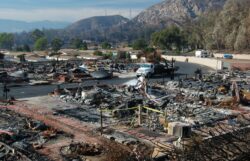The Most Common Types of Mass Tort Environmental Lawsuits
Climate change litigation has emerged as a significant trend in environmental law worldwide. This transformative development is witnessing a rise in legal actions initiated to address the pressing issue of climate change.

Such actions encompass holding governments accountable for their environmental policies and suing corporations for their contribution to environmental damage.
This article will delve into international accords' role and the distinction between public and private legal battles in shaping this landscape. Furthermore, it will critically examine landmark court cases and their consequent impact, providing a comprehensive understanding of the future projections for such legal actions.
The article will also discuss the legal challenges and obstacles faced, while highlighting the power of legal precedents.
Thus, this in-depth exploration will underscore why climate change litigation is set to become the next big thing in environmental law.
Key Takeaways
- Rise of climate change litigation as a powerful tool in holding entities accountable for environmental degradation
- Increasing demand for greater responsibility from governments and corporations in addressing climate change
- Role of legal precedents in shaping the trajectory of climate change litigation and environmental law
- Potential for climate change litigation to drive transformative societal change and foster environmental justice
The Rise of Legal Actions Against Climate Issues
A burgeoning trend in environmental law is the escalating number of legal actions being instigated against climate-related issues, signalling a potential revolution in the way societies demand accountability for environmental degradation. This surge is largely driven by the increasing recognition of the devastating impacts of climate change and the urgency for effective action.
As such, climate legislations are evolving to incorporate mechanisms for legal recourse, giving rise to a new wave of climate change litigation.
The spate of legal actions has been further propelled by substantial litigation funding. Litigation funders, recognising the potential for substantial damages in climate-related lawsuits, are increasingly willing to finance these actions. Their involvement has effectively transformed the litigation landscape, enabling parties with limited resources to initiate legal proceedings against powerful entities, such as multinational corporations and governments, who contribute significantly to environmental degradation.
The growing body of climate legislations and the emergence of litigation funding have together created a conducive environment for climate change litigation. The surge in legal actions has not only brought attention to the urgent need for climate action, but it has also underscored the potential of the law as an instrument to hold polluters accountable and foster environmental justice.
This trend of legal actions against climate issues demonstrates the evolution of environmental law, where it is not just about regulation and compliance but also about enforcement and accountability. It signifies a shift in societal attitudes, demanding greater responsibility from those contributing to environmental degradation and the climate crisis.
Thus, climate change litigation is poised to become an instrumental tool in the fight against climate change.
Holding Governments Accountable
In a rapidly shifting legal landscape, governments worldwide are being held accountable for their roles in exacerbating or failing to mitigate ecological degradation. This shift represents a significant development in environmental law, with climate change litigation emerging as a powerful tool for policy enforcement and the pursuit of climate justice.
Legal cases are increasingly challenging governments on their climate policies, or lack thereof, asserting that they have a duty to protect the environment for current and future generations. An exemplar of this trend is the historic Urgenda case in the Netherlands. In this landmark ruling, the Dutch Supreme Court upheld a decision that the government had not only a legal but also a moral obligation to significantly reduce greenhouse gas emissions by 2020. This ruling set a legal precedent, demonstrating that governments could be held legally responsible for insufficient action on climate change.
Simultaneously, in the United States, the case of Juliana v. United States is currently unfolding. Initiated by 21 youth plaintiffs, the case argues that the U.S. government's actions contributing to climate change violate their constitutional rights to life, liberty, and property. While this case is yet to reach a final verdict, it underscores the increasing momentum of climate change litigation.
This legal trend towards holding governments accountable is an affirmation of the principle of climate justice. It recognizes the rights of current and future generations to a stable climate and a healthy environment. Thus, climate change litigation is not merely a legal phenomenon, but a powerful mechanism advocating for policy enforcement and transformative societal change.
Suing Corporations for Environmental Damage
Shifting the focus from government responsibility, the legal realm has recently witnessed an uptick in cases where corporations are held responsible for ecological degradation. This trend is indicative of a shift towards corporate accountability in environmental law. Corporate entities, often major contributors to environmental pollution, are increasingly being subjected to litigation that seeks to hold them liable for the adverse ecological impacts of their operations.
Case law provides several instances where courts have imposed pollution penalties on corporations. A notable example is the 2015 Volkswagen emissions scandal where the corporation was caught using software to cheat emission tests. Volkswagen was subsequently sued by various entities and was compelled to pay billions of dollars in pollution penalties. This case elucidates the increased willingness of courts to hold corporations accountable for their adverse environmental impact.
Another instance is the lawsuit against Chevron by the Nigerian community of Ogale, holding the corporation responsible for the severe environmental damage caused by oil spills. The case, currently in the United Kingdom Supreme Court, could set a precedent for holding corporations accountable for environmental damage, even when the damage occurs outside of their home country.
Such litigation not only imposes costs on corporations for their unsustainable practices but also deters other corporations from adopting similar practices. It signals the growing importance of corporate accountability in environmental law and the potential for litigation to be used as a tool to combat climate change.
These cases underline the emerging trend of suing corporations for environmental damage and the potential of such litigation in driving more sustainable corporate practices.
The Role of International Accords
Turning to the global stage, international agreements have emerged as pivotal instruments in the fight to protect the planet's ecological integrity. These agreements, often in the form of treaties or accords, bind nations to specific environmental standards and practices. The enforcement of these accords, however, can be a contentious issue, leading to a surge in climate change litigation.
Accord enforcement is integral to the effectiveness of these international agreements. When nations fail to comply with these accords, it jeopardizes the collective effort to mitigate environmental damage. In such cases, climate change litigation serves as a crucial tool for enforcement, holding non-compliant nations accountable for their actions.
The interpretation of these agreements, specifically in the form of treaty interpretation, often becomes a central issue in climate change litigation. The language of these accords, while aimed at unambiguous stipulations, can sometimes be open to interpretation. Courts, through litigation, are tasked with deciphering the exact obligations of each signatory nation.
Case analysis reveals that this form of litigation is essential in ensuring that signatories are not merely paying lip service to environmental protection. For instance, the Urgenda case in the Netherlands, where the government was sued for not meeting the emissions reductions targets set out in the European Union's international agreements, exemplifies how legal action can enforce these accords.
This trend in environmental law suggests a shift towards a more proactive and legally binding approach to combating climate change. It underscores the increasing relevance of accord enforcement and treaty interpretation in holding nations accountable and ensuring the success of international environmental agreements.
Public and Private Legal Battles
Legal disputes concerning ecological concerns have seen a rise not only on the international stage but also within the public and private sectors. The focal point of these disputes is increasingly geared towards climate justice through legal enforcement. There has been a significant shift in the legal landscape, with climate change litigation becoming a potent tool for advocacy, policy shaping, and ensuring accountability.
Public and private legal battles are now being fought in courtrooms, with plaintiffs ranging from states and municipalities to non-governmental organizations and private individuals. The allegations vary, including failure to mitigate climate change impacts, not adapting to its consequences, and even contributing to the climate crisis. These litigations serve as a crucial mechanism to enforce legal obligations related to the environment, thereby ensuring climate justice.
A prominent example of such litigation is the recent case of Urgenda Foundation v. The State of the Netherlands. The Dutch Supreme Court upheld the lower court's ruling that the government has a legal duty to reduce greenhouse gas emissions by at least 25% by the end of 2020. This landmark case has set a precedent for climate change litigation, affirming the role of the judiciary in enforcing climate justice.
These lawsuits underscore the fact that addressing climate change is not merely a political or economic issue but a legal one. They compel governments and corporations to uphold their environmental obligations and contribute to the global fight against climate change. This underlines the growing importance of climate change litigation in environmental law and its role in achieving climate justice.
The Influence of Activists and NGOs
In the wake of public and private legal battles, the role of activists and Non-Governmental Organizations (NGOs) has emerged as a potent force in the arena of climate change litigation.
The significance of activists in this burgeoning field is undeniable. Activists, armed with extensive training, have become formidable players in the legal battles against climate change. Activist Training, which entails comprehensive education on environmental law, climate science, and litigation tactics, has equipped activists with the requisite knowledge and skills to confront climate change issues in courtrooms. By doing so, they have been able to effectively articulate the urgency and necessity of climate change action, compelling courts and corporations alike to reconsider their environmental decisions.
In parallel, NGOs have also become key players in the sphere of climate change litigation. Through strategic NGO partnerships, these organizations have been able to pool resources, share expertise, and coordinate global efforts, thereby enhancing the impact and reach of climate litigation. NGOs, such as Greenpeace and the Sierra Club, have used litigation to challenge governmental and corporate actions contributing to climate change, setting legal precedents and pushing for stricter environmental regulations.
Moreover, activists and NGOs are increasingly collaborating, harnessing their collective strengths to drive forward the climate change litigation agenda. These collaborations have not only amplified their voices but have also bolstered the legal strategies employed in climate change litigation.
Without a doubt, the influence of activists and NGOs has been transformative in the realm of climate change litigation. They have emerged as catalysts of change, pushing the boundaries of environmental law and shaping it to respond to the pressing challenge of climate change.
Landmark Court Cases and Their Impact
Significant court cases have left indelible marks on the landscape of global efforts against increasing temperatures, providing pivotal legal precedents and influencing future actions. As climate change litigation expands, environmental health litigation, in particular, has gained momentum, demonstrating the connection between environmental degradation and public health.
One such case is Juliana v. United States, where a group of young plaintiffs argued that the government violated their constitutional rights to life, liberty, and property by failing to prevent climate change. Not only did the case highlight the government's responsibility in climate adaptation laws, but it also underscored the role of courts in holding governments accountable for their climate actions.
Another landmark case is Urgenda Foundation v. The State of Netherlands, which marked a significant victory for climate justice. The Dutch Supreme Court upheld a lower court's ruling that the Dutch government had explicit duties to reduce greenhouse gas emissions by at least 25% by 2020. This case was unique in its successful argument that the government had a legal duty to protect its citizens from climate change, thereby setting a precedent for similar legal arguments globally.
In the realm of environmental health litigation, the case Lliuya v. RWE holds significance. This case saw a Peruvian farmer suing German energy company RWE over its contribution to climate change, which threatened his home and livelihood. The case highlighted the potential liability of companies for their greenhouse gas emissions, thereby encouraging other affected communities to seek legal redress.
These cases demonstrate the growing recognition of climate change litigation's potential to shape environmental policy and compel governments and corporations to take serious action against climate change.
Future Projections for Legal Actions
As the world continues to grapple with the escalating threats of global warming, the role of the judicial system in shaping sustainable policies and holding parties accountable for their actions is expected to intensify. The legal landscape is poised to witness a proliferation of climate change litigation, significantly impacting the future of environmental law.
Litigation funding is becoming an essential tool for plaintiffs in these cases. The high costs associated with such lawsuits often deter affected parties from seeking justice. However, with the rise of litigation funding, vulnerable communities, and individuals can now raise lawsuits against corporations, governments, and other entities implicated in climate change. This trend is likely to fuel a surge in climate change litigation, further entrenching its significance in environmental law.
Moreover, the plight of climate refugees is predicted to underscore the importance of climate change litigation. As escalating environmental crises displace more individuals and communities, the legal recognition and protection of climate refugees will likely come into sharp focus. Legal action may offer a mechanism for these refugees to seek redress, challenge inadequate policies, and demand more robust climate action.
Anticipating these developments, it is evident that the nexus between climate change and litigation will continue to grow, with courts expected to play a more active role in climate governance. This shift will likely redefine the contours of environmental law, highlighting the critical role of legal mechanisms in addressing climate change.
The anticipated proliferation of climate change litigation underscores the growing importance of judicial intervention in the fight against global warming.
Legal Challenges and Obstacles
While it is anticipated that the future will witness an increasing number of legal actions pertaining to climate change, it is equally important to understand the potential challenges and obstacles that could be encountered in the process. The legal framework is a labyrinth that requires an intricate understanding of its complexities, particularly when dealing with issues of such global magnitude as climate change.
The realm of climate change litigation is marked by the interplay of climate legislation and sustainable policies, which both bear significant implications on the legality of certain actions and decisions. However, the current legal landscape is fraught with potential roadblocks. Firstly, climate legislation is often a political hotbed, with the potential to be influenced by partisan biases that could hamper the implementation of effective regulations.
Secondly, the enforcement of sustainable policies can often be met with resistance from industries and corporations that may be negatively impacted by such policies.
Moreover, the very nature of climate change litigation presents its own unique set of challenges. The global scale and complexity of the issue may raise questions regarding jurisdiction and the appropriateness of holding individual entities accountable for a problem that is collectively caused. Furthermore, the unprecedented nature of these lawsuits can lead to uncertain outcomes, as there are few precedents to guide judicial decisions.
To overcome these obstacles, it is crucial to establish robust climate legislation and sustainable policies that are not only legally binding but are also flexible enough to adapt to the evolving dynamics of climate change. Without succumbing to a sense of finality, it is worth noting that the efficacy of climate change litigation as a tool in combating environmental degradation hinges significantly on our ability to navigate these legal challenges.
The Power of Legal Precedents
The potency of legal precedents in shaping future decisions cannot be underestimated, especially when addressing global concerns of such magnitude as climate change. In the realm of environmental law, the influence of precedent on subsequent judicial interpretations is paramount. These legal precedents, once established, provide a roadmap for future litigation and can significantly influence the outcomes of subsequent cases.
However, the application of these precedents is not without its limitations. The principle of stare decisis, which suggests courts should follow precedent unless there is a strong reason to do otherwise, can sometimes be a double-edged sword. While it ensures consistency and predictability in legal decisions, it can also restrict the flexibility of the courts to adapt to new scientific evidence or evolving societal values, particularly in the dynamic field of climate change litigation.
Moreover, the interpretation of precedents is heavily reliant on the discretion of the judiciary. Different judges might interpret the same precedent in divergent ways, leading to inconsistent rulings. This highlights the pivotal role of judicial interpretations in shaping the trajectory of environmental law.
Case analysis has shown that courts are increasingly open to innovative legal arguments in climate change litigation. For instance, landmark cases such as the Urgenda case in the Netherlands and the Juliana case in the United States have created novel precedents by recognizing the legal obligations of governments to mitigate climate change. These precedents have the potential to transform the landscape of environmental law by paving the way for similar lawsuits worldwide.
The power of precedents and judicial interpretations in climate change litigation underscores the evolving nature of environmental law and its capacity to address pressing global challenges. It is evident that this form of litigation will continue to play a significant role in the legal response to the climate crisis.
Frequently Asked Questions
What is the role of environmental lawyers in climate change litigation?
Environmental lawyers play a pivotal role in climate change litigation. They develop litigation strategies to pursue climate justice. They meticulously analyze cases to identify potential legal avenues. They persuasively argue for the enforcement of existing environmental laws and push for the development of new legislation. These legal professionals serve as vital advocates in the fight against climate change. They make use of the law to hold responsible parties accountable and to seek remedies for those affected by environmental degradation.
How does climate change litigation impact local communities?
Climate change litigation directly impacts local communities in several ways. Firstly, it influences environmental policies and laws, which can have significant implications for these communities. This can lead to the implementation of regulations that aim to reduce greenhouse gas emissions, protect natural resources, and promote sustainable practices.
However, climate change litigation can also have negative consequences for local communities. One such impact is the high costs associated with legal proceedings. These costs can burden communities, potentially diverting resources from other crucial areas such as education, healthcare, or infrastructure development. This financial strain can hinder the ability of communities to address pressing needs and adapt to the changing climate.
On the other hand, climate change litigation can also bring positive outcomes that benefit local communities. Legal proceedings can compel responsible parties, such as corporations or governments, to take action to mitigate climate impacts. This can include implementing measures to reduce emissions, investing in renewable energy sources, or adopting sustainable practices. Additionally, litigation can also result in the funding of adaptation measures that help communities cope with the environmental changes they are experiencing.
Furthermore, climate change litigation can lead to compensation for affected communities. This can provide much-needed resources to support community resilience efforts and help them recover from the damages caused by climate change. By holding responsible parties accountable, litigation can contribute to the overall well-being and sustainability of local communities.
In conclusion, the impact of climate change litigation on local communities is multifaceted. While high litigation costs can burden communities, positive outcomes such as mitigation efforts, funding for adaptation measures, and compensation can enhance community resilience and contribute to their ability to cope with environmental changes. The overall impact on local communities is shaped by the outcomes of these legal battles and the subsequent implementation of policies and measures.
Are there any specific regions or countries that see more climate change litigation than others?
Climate litigation's effectiveness varies among regions, reflecting disparities in legal systems and funding for climate litigation.
Predominantly, the United States, Australia, and the United Kingdom experience the highest number of climate change lawsuits. These jurisdictions have robust legal frameworks and resources to support such litigation.
However, it is noteworthy that emerging economies and developing nations are increasingly utilizing legal mechanisms to address climate change, albeit with varying degrees of success.
How are legal education institutions incorporating climate change litigation into their curriculum?
Legal education institutions are tackling curriculum challenges by integrating climate change litigation into their courses. Innovative pedagogical approaches are being employed to impart knowledge on this significant aspect of environmental law.
These institutions are focusing on creating comprehensive case studies, providing detailed analysis, and fostering persuasive argumentation skills pertinent to climate litigation. This educational transformation aims to equip future legal practitioners with the necessary skills and knowledge to navigate this emerging and pivotal field.
Can climate change litigation be considered a form of protest or civil disobedience?
Climate change litigation, while sharing similarities with protest or civil disobedience, primarily serves as a legal tool for enforcing environmental laws and regulations. It involves the establishment of legal precedents and the analysis of litigation outcomes to advance climate justice.
Such litigation challenges policy and corporate actions or inactions related to greenhouse gas emissions, and thereby influences future legal and policy decisions. Therefore, it functions more as a mechanism for legal accountability rather than a form of protest.
Conclusion
In conclusion, climate change litigation is gaining prominence as a tool to hold governments and corporations accountable for environmental damage. It is becoming a potent instrument in the global fight against climate change.
Despite legal challenges and obstacles, the power of legal precedents and international accords provide a promising path forward. This evolution in environmental law holds potential for shaping future climate policies and corporate responsibility, marking a significant shift in environmental governance.

This post has been generated by AI and was not reviewed by editors. This is Not legal advice. Please consult with an attorney.




